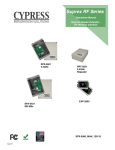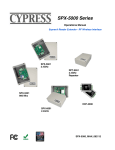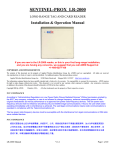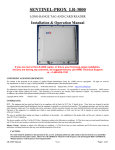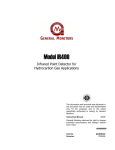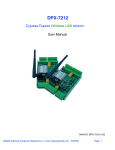Download Cypress SPX-5500 Series Specifications
Transcript
SPX-5500 Series Operations Manual RF 900Mhz Suprex® Reader SPX-5511 pictured SPX-5500SS Cypress Suprex SPX-5500 Series Overview: The SPX-5500 series of RF Wireless solutions provide a wireless bridge from card readers with gates or door hardware to most access control manufacturerʼs panels. The SPX or Suprex products include both the remote ( Door/Gate ) unit and the central ( AC Panel ) unit. Features: -- Service mode for setup and configuration. --“Quiet” protocol to conserve bandwidth and power -- Field configurable reader formats -- Multifunction indicator for determining operational status of the unit -- Auxiliary I/O connections available for Door/Gate/Panel status signaling. -- Multiplexing of RF bridge providing for additional door/gate on a single RF link. (future) Electrical Specifications: (Each Unit) Supply Voltage# Current# # # # 8-16VDC 500mA RF Specifications: 900Mhz frequency spread spectrum - no licensing required Physical Temp Humidity Power Data I/O SPX-5501/5511 - Weatherproof Enclosure 6.75” x 3.75” x 2.00” Storage(-55˚C to + 150˚C) Operating(-40˚C to +80˚C) 95% (non-condensing) Input Unreg Input 8 to 16 VDC* @ 300mA Max Output +5VDC @100mA Interface Reader -Wiegand, Strobed (Clock & Data), F/2F LED - 0 - 30V This complies with part 15 of the FCC rules Operation is subject to the following two conditions: (1) This device may not cause harmful interference, and (2) this device must accept any interference received, including interference that may cause undesired operation. Cypress Computer Systems 1778 Imlay City Rd WWW.CypressWorld.com [email protected] Lapeer, MI 48446 Copyright @2010 External connections and DIP Switch Settings 1-Relay1 Input 2-Relay2 Input 3-Aux Out 4-Ground 5-RLY3 N.C. 6-RLY3 Com 7-RLY3 N.O. 8-RLY4 N.C. 9-RLY4 Com 10-RLY4 N.O. 1-D0/CLK Output 2-D1/Data Output 3-LED In 4-Prog Res 1 5-Prog Res 2 6-+5 VDC Out 7-N/C 8-N/C RFX SPX-5500 - 5000 Series Central Unit Diagnostic LED 1-Ground 2-8 to 16 VDC In N/C N/C 3-Aux Input 4-Ground 5-RLY1 N.C. 6-RLY1 Com 7-RLY1 N.O. 8-RLY2 N.C. 9-RLY2 Com 10-RLY2 N.O. 1-D0/CLK Input 2-D1/Data Input 3-LED Output 4-Relay 3 In 5-Relay 4 In 6-+5 VDC Out 7-N/C 8-N/C RFX SPX-5500 - 5000 Series Remote Unit Diagnostic LED 1-Ground 2-8 to 16 VDC In Central Unit Settings Remote Unit Settings DIP Switch #1 ON -Service Mode DIP Switch #1 OFF -Quiet Mode DIP Switch #1 ON -Service Mode DIP Switch #1 OFF -Quiet Mode 1 2 3 4 5 6 7 8 1 2 3 4 5 6 7 8 Dip switch #4 is ON -Enable Pullup resistors Dip switch #4 is ON -Disable Pullup resistors Dip switch #4 is OFF -Enable Pullup resistors Wiegand Wiegand / No Filter Strobed Rising Edge (MR-5) Strobed Rising Edge (Dorad0 644) Strobed Rising (Mag-Tek) Strobed Falling Edge Reserved F2F Dip switch #4 is OFF -Disable Pullup resistors Switch 6 7 8 0 1 2 3 4 5 6 7 x x x x x x x x x x x x x = ON Wiegand Wiegand / No Filter Strobed Rising Edge (MR-5) Strobed Rising Edge (Dorad0 644) Strobed Rising (Mag-Tek) Strobed Falling Edge Reserved F2F 0 1 2 3 4 5 6 7 Switch 6 7 8 x x x x x x x x x x x x x = ON Quick Reference For Typical Connections SPX-5000 Series Central Quick Reference R1 IN R1 Input Controls Strike on Remote D0/Clock D1/Data LED D0/Clock Out D1/Data Out LED In Access Control Panel Switch #4 ON Disable Pullup Resistors Switch #4 OFF Enable Pullup Resistors Diagnostic LED (-) Ground +8 to +16 VDC (+) Suprex RF Central Typical Suprex Central Connections DC Power Supply 1 2 3 4 5 6 7 8 Switch 6 7 8 Wiegand Wiegand / No Filter Strobed Rising Edge (MR-5) Strobed Rising Edge (Dorad0 644) Strobed Rising (Mag-Tek) Strobed Falling Edge Reserved F2F 0 1 2 3 4 5 6 7 x x x x x = ON x x x x x x x x SPX-5000 Remote D0/Clock In D1/Data In LED Out Door Strike LED Card Reader R1 N.C. R1 Com R1 N.O. Switch #4 OFF Disable Pullup Resistors Diagnostic LED (-) Ground +8 to +16 VDC (+) Suprex RF Remote Typical Suprex Remote Connections Switch #4 ON Enable Pullup Resistors DC Power Supply 1 2 3 4 5 6 7 8 Wiegand Wiegand / No Filter Strobed Rising Edge (MR-5) Strobed Rising Edge (Dorad0 644) Strobed Rising (Mag-Tek) Strobed Falling Edge Reserved F2F Switch 6 7 8 0 1 2 3 4 5 6 7 x x x x x x x x x x x x x = ON Cypress Suprex RF Series - Introduction SPX-5000 Series: This manual covers the operation and setup of the Cypress Suprex RF (5000 Series) units. Several configurations are available with different enclosure and antenna options. All of the units with the 5000 series part number will have the same operational functions and electrical connections. Features: -- DES56 Encryption for secure communications -- Units are factory configured as matched pairs, no field channel setting is required. -- Service mode for setup and configuration. --“Quiet” RF protocol to conserve bandwidth and power -- Field configurable reader formats -- Multifunction indicator for determining operational status of the unit -- Auxiliary I/O connections available for Door/Gate/Panel status signaling. Electrical Specifications: (Each Unit) Supply Voltage# Current# # # # 8-16VDC 500mA Radio Specifications: Frequency# # # Type ## # # Transmit Power# # Receive Sensitivity## Interference Rejection# 900 MHz ISM band Frequency Hopping Spread Spectrum 100mW -110 dBm 70dB Antenna Options and typical range: Internal - Up to 500 feet #(SPX-5501) Dipole - up to 1 Mile (SPX-5511) Yagi - Up to 12,000 feet. (SPX-5531) Distances given are typical line of sight. Actual distance will vary depending upon terrain, RF environment, and height of antenna. The units are shipped configured as a matched pair and are ready to plug in and operate. The RF units are capable of operating with multiple pairs of units in the same environment. Units on different channels can operate in the same area with minimal interference to each other. Unit channel selection is made at the factory and no field settings are necessary. Up to 8 pairs of units can operate in the same area. A serial number sticker will be present on the unit to indicate the paired units. Units matched as a pair will have the same serial number or other identification labels. Individual units should maintain a 24" separation distance from each other when installed in a central location. Unpacking: Cypress Suprex RF Series - Setup and Preinstallation Remove covers from units and check interior for any shipping damage. Remove any packing material if present. Inventory any included parts (depending on model) such as antennas, coax cables etc. Bench Testing: Before installing the units in the field they should be assembled and tested at a convenient “Bench top” location. This will make it easier to verify / change settings and check operation when both units are visible at the same time. It is also a chance to become familiar with the system if this is the first time using the Suprex system. It is much more difficult to setup and test the units when they are several thousand feet apart. Both units will need to have the antenna and a suitable power supply connected. For testing purposes, the units can share the same power supply. During initial setup it is helpful to use the Setup/Config mode. This allows a relative indication of the radio link quality between the units. Basic Bench Test: 1. Connect any antennas if the unit has a removable type antenna such as a dipole or Yagi. 2. Connect a suitable power supply to both units. Each unit should be provided with 8 - 16 volts DC and approx 300mA. Both units should be separated by a minimum of 24 inches. 3. Apply power. After about a 1 -2 second delay both units Diagnostic LED should indicate Green. 5. Touch a jumper wire from the Ground connection the the Relay 1 input on the Central unit. Relay #1 on the Remote unit should activate with an audible click and the Diagnostic LEDs should flash green on both the Central and Remote units. 6. Units are shipped from the factory set for the Wiegand data format. If a different format is required set the DIP switch to the required reader and panel format. 7. If a reader and panel is accessible, connect the reader to the Remote unit and the Central unit to the panel and verify that card reads are being accepted by the access control system. If any troubleshooting is necessary, it will be easier to do with both units in close proximity to each other. 8. Once these steps are completed, the units are ready for installation it their permanent locations and final commissioning as a system. Cypress Suprex RF Series - Indicators and Operating Modes LED Diagnostic Indicator: The LED Diagnostic indicator provides information on the operational status of the unit. If the units are not communicating, viewing the diagnostic indicator LEDʼs may help to determine the nature of the problem. When the Suprex units are operating correctly and have a valid communication channel between the Remote and Central units, the Diagnostic indicators on each unit will flash green rapidly (2-3 flashed per second) in Service / Config mode and illuminate a steady green in quiet mode. DIAGNOSTIC LED NOT ILLUMINATED: If the LED(s) are not illuminated on the unit(s) then the unit is not getting power or there is an electrical problem. The Diagnostic LEDʼs will be illuminated Red/Green or flashing whenever power is applied. CENTRAL UNIT FLASHING BETWEEN RED/GREEN: With power applied and no communication path between the Remote and Central, the Central unit will flash the diagnostic indicator alternately between Red and Green. REMOTE UNIT ILLUMINATED RED: The Remote unit will diagnostic LED will illuminate solid (not flashing) red if it is not receiving communication from the Central. REMOTE AND CENTRAL UNITS FLASHING BETWEEN RED/GREEN: The Central is not Receiving communication from the Remote. Operating modes: By setting DIP switch 1 to the ON position, the unit is placed in Setup / Config mode. When the switch position is changed, cycle power to the unit to make the switch change take effect. In "Quiet" mode (DIP switch #1 OFF) the units will remain quiet unless there is a status change, and will slowly poll each other about every 10 to 15 seconds to check the link integrity. The Setup / Config mode places the units in a rapid polling sequence to allow troubleshooting and setup of the communication link. The Duprex RF units use a quiet protocol when operating in Quiet mode. Communication between the Central and Remote unit only occurs when an event requires data transmission or contact needs to be made to maintain supervision. The RF channel remains quiet most of the time. During setup or troubleshooting it may be necessary to observe the communication link between the Central and Remote units. The rapid polling used in the Setup / Config mode can help indicate whether the units can “See” each other. Additionally the Central unit Diagnostic LED will indicate Red when communication is lost. In some cases an optimal mounting location can be selected by operating one of the units on a small 12 volt battery and moving the location while observing the diagnostic LED indicators. Cypress Suprex RF Series - Field Installation Mounting the Units: A site evaluation should have determined the optimal locations for the Central and Remote units, the type of antennas that would be needed, and the frequency band to be used. (See Cypress Application Note “Site Evaluation for Duprex RF products”). This section of the document covers units that utilize the enclosure mounted1/2 wave whip antenna. For other types of antennas there will be specific documentation to cover their different installation issues. We are now ready to physically mount the units and make the electrical connections to complete the installation. The units should be mounted so that the length dimension of the antennas are in the same plane. The orientation of the antenna will determine what is referred to as the polarization of the signal. Significant reduction in range can result if the units are not oriented with the same polarity. See below. Both Central and Remote units are arranged so the antennas are parallel in direction. As shown in this illustration. We would say they are both vertically polarized. Since the polarity is in the same direction, the signal strength would be maximized. In this instance one of the units is vertically polarized, and the other is horizontally polarized. The signal would be greatly reduced thereby reducing the maximum distance between units. The installer should make sure that both units are mounted so that the polarization will be the same for both units. In all cases the antennas MUST be mounted at a distance of 20 cm or greater from any nearby persons Cypress Suprex RF Series - Field Installation This orientation may reduce range. The metal pole is placed between antenna and other unit and the antenna is close to metal. The units should be mounted in such a way that there is as clear of a path as possible between the 2 units. If mounting to a post or wall the unit should be placed where it has minimal interference with the antenna. Maximum signal and ranges are achieved when the antenna is clear of obstructions and is placed away from metal objects. Better, improved range. Antenna has line of sight to other unit. Proximity to metal pole may reduce range. Best, antenna has line of sight to other unit and is clear of adjacent metal objects. In all cases the antennas MUST be mounted at a distance of 20 cm or greater from any nearby persons Cypress Suprex RF Series - Door Strike and LED I/O Note: The LED and Door Strike operation of the RF Suprex differs from previous Suprex versions. To activate the relay on the Remote unit, connect as shown below. These connections can be used to allow the Remote relay to operate a DOOR STRIKE, GATE, or other locking hardware. Refer to following pages in this document for details of each I/O operation and connection. There are two relays available for accessory outputs at the Remote end. Either relay can be used to provide the Door Strike or Gate activation function. This example uses Relay 1. Wiring Example - Door Strike Follows LED R1 IN R1 Input Controls Strike on Remote LED In LED Signal Ground Access Control Panel Suprex RF Central Ground Only Relay and LED Connections are shown for clarity, refer to previous diagrams for Power and Data connections. Wiring Example - Door Strike does not follow LED Strike Signal R1 IN LED In LED Signal Ground Suprex RF Central Ground Access Control Panel Cypress Suprex RF Series - Door Strike and LED I/O The Cypress RFX-5000 provides additional data channels to support access control hardware such as door strikes, tamper alarms, request to exit status, etc. These signals are sent to and from the Remote and Central units without the need to run additional wiring. The accessory control I/O use active low inputs. When the inputs are floating (nothing connected) the associated output will be set to a high level. When the input is set to 0 Volts (Ground) the input will activate its associated output. All Accessory outputs are Open Collector type and will switch to Ground when activated. Each input will have an associated output. See the following pages for a diagram of each I/O pair. Inputs can be tested by making a jumper connection to ground and monitoring the associated output. Input LED In Jumper to ground to test Ground Suprex RF Central Red arrow denotes direction of command signal Output LED Out Suprex RF Remote Cypress Suprex RF Series - Relay Controls Input Signal Relay 1 IN Suprex RF Central Contact Outputs Relay 1 N.C Relay 1 Com Relay 1 N.O. Suprex RF Remote Cypress Suprex RF Series - Relay Controls Input Signal Relay 2 IN Suprex RF Central Contact Outputs Relay 2 N.C Relay 2 Com Relay 2 N.O. Suprex RF Remote Cypress Suprex RF Series - Relay Controls Contact Outputs Relay 3 N.C Relay 3 Com Relay 3 N.O. Suprex RF Central Input Signal Relay 3 IN Suprex RF Remote Relay 3 functions as an Alarm relay and monitors the condition of the communication link between the Central and Remote units. Relay 3 is activated when power is applied and the communication link between the Central and Remote is functioning. Relay 3 will become deactivated (Alarm condition) when either the Relay 3 input on the remote is active OR the Remote unit is unable to communicate with the Central unit. Cypress Suprex RF Series - Relay Controls Contact Outputs Relay 4 N.C Relay 4 Com Relay 4 N.O. Suprex RF Central Input Signal (5Volts DC Maximum) Relay 4 IN Suprex RF Remote Cypress Suprex RF Series - Auxillary I/O Aux Output Signal AUX OUT Suprex RF Central Aux Input Signal AUX IN Suprex RF Remote
















